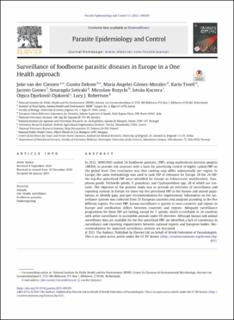| dc.description.abstract | In 2012, WHO/FAO ranked 24 foodborne parasites (FBP) using multicriteria decision analysis (MCDA) to provide risk assessors with a basis for prioritising control of highly ranked FBP on the global level. One conclusion was that ranking may differ substantially per region. In Europe, the same methodology was used to rank FBP of relevance for Europe. Of the 24 FBP, the top-five prioritised FBP were identified for Europe as Echinococcus multilocularis, Toxoplasma gondii, Trichinella spiralis, E. granulosus, and Cryptosporidium spp., all of which are zoonotic. The objective of the present study was to provide an overview of surveillance and reporting systems in Europe for these top five prioritised FBP in the human and animal populations, to identify gaps, and give recommendations for improvement. Information on the surveillance systems was collected from 35 European countries and analysed according to the five different regions. For most FBP, human surveillance is passive in most countries and regions in Europe and notification differs between countries and regions. Adequate surveillance programmes for these FBP are lacking, except for T. spiralis, which is notifiable in 34 countries with active surveillance in susceptible animals under EU directive. Although human and animal surveillance data are available for the five prioritised FBP, we identified a lack of consistency in surveillance and reporting requirements between national experts and European bodies. Recommendations for improved surveillance systems are discussed. | |
